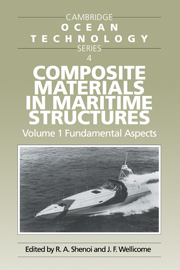Book contents
- Frontmatter
- Contents
- Preface
- List of Authors
- 1 A Strategic Overview
- 2 Background to Materials Science
- 3 Environmental Aspects
- 4 Production by Resin Transfer Moulding
- 5 An Engineering Approach to the Prediction of Elastic Properties of a Laminate
- 6 Mechanics of Orthotropic Laminae
- 7 Analysis of Laminated Composites
- 8 Theory of Sandwich Beams and Plates
- 9 Design of Anisotropic Panels
- 10 Finite Element Analysis of Composites
- 11 Theoretical Predictions of Failure Mechanisms and Strength
- 12 Considerations of Failure Theories in Design
- 13 The Procedures and Standards
- Appendix
- Index
4 - Production by Resin Transfer Moulding
Published online by Cambridge University Press: 04 August 2010
- Frontmatter
- Contents
- Preface
- List of Authors
- 1 A Strategic Overview
- 2 Background to Materials Science
- 3 Environmental Aspects
- 4 Production by Resin Transfer Moulding
- 5 An Engineering Approach to the Prediction of Elastic Properties of a Laminate
- 6 Mechanics of Orthotropic Laminae
- 7 Analysis of Laminated Composites
- 8 Theory of Sandwich Beams and Plates
- 9 Design of Anisotropic Panels
- 10 Finite Element Analysis of Composites
- 11 Theoretical Predictions of Failure Mechanisms and Strength
- 12 Considerations of Failure Theories in Design
- 13 The Procedures and Standards
- Appendix
- Index
Summary
INTRODUCTION
At the introduction of the reinforced plastic products just after World War II the hand lay-up technique was used for the production of those products. This technique has persisted as the years passed on because it is a simple, handcrafted technique with low cost tooling. As with all handcrafted techniques, the quality of the products depends on the individual craftsmanship of the operator. Even with good craftsmanship the products only have one side with defined geometry, the thickness of the products is not well controlled and consequently the fibre-volume fraction can only be guaranteed within a wide range. Moreover the material will contain a considerable number of air bubbles, or voids.
The technique is time consuming and consequently wage expenditure is the greater part of the cost price of the product and the cycle time for moulding is rather long. For volume manufacture of a product several moulds have to be used to achieve sufficient productivity. As the years passed attempts were made both to improve the productivity of the process and to raise the quality of the product.
A first attempt to raise the productivity and to lower labour costs was the spray lay-up technique but this was achieved at the cost of lower mechanical properties. The loss of mechanical properties is due to the fact that with this technique a random fibre distribution in all directions is obtained and tailoring the anisotropy of the material to the loading of the product is not possible.
- Type
- Chapter
- Information
- Composite Materials in Maritime Structures , pp. 86 - 126Publisher: Cambridge University PressPrint publication year: 1993
- 5
- Cited by

